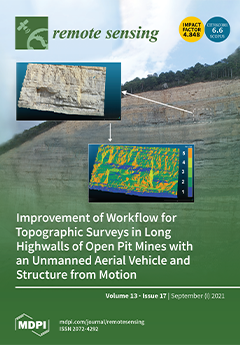The continuing increase in atmospheric CO
2 concentration caused by anthropogenic CO
2 emissions significantly contributes to climate change driven by global warming. Satellite measurements of long-term CO
2 data with global coverage improve our understanding of global carbon cycles. However, the sensitivity of the space-borne measurements to anthropogenic emissions on a regional scale is less explored because of data sparsity in space and time caused by impacts from geophysical factors such as aerosols and clouds. Here, we used global land mapping column averaged dry-air mole fractions of CO
2 (XCO
2) data (Mapping-XCO
2), generated from a spatio-temporal geostatistical method using GOSAT and OCO-2 observations from April 2009 to December 2020, to investigate the responses of XCO
2 to anthropogenic emissions at both global and regional scales. Our results show that the long-term trend of global XCO
2 growth rate from Mapping-XCO
2, which is consistent with that from ground observations, shows interannual variations caused by the El Niño Southern Oscillation (ENSO). The spatial distributions of XCO
2 anomalies, derived from removing background from the Mapping-XCO
2 data, reveal XCO
2 enhancements of about 1.5–3.5 ppm due to anthropogenic emissions and seasonal biomass burning in the wintertime. Furthermore, a clustering analysis applied to seasonal XCO
2 clearly reveals the spatial patterns of atmospheric transport and terrestrial biosphere CO
2 fluxes, which help better understand and analyze regional XCO
2 changes that are associated with atmospheric transport. To quantify regional anomalies of CO
2 emissions, we selected three representative urban agglomerations as our study areas, including the Beijing-Tian-Hebei region (BTH), the Yangtze River Delta urban agglomerations (YRD), and the high-density urban areas in the eastern USA (EUSA). The results show that the XCO
2 anomalies in winter well capture the several-ppm enhancement due to anthropogenic CO
2 emissions. For BTH, YRD, and EUSA, regional positive anomalies of 2.47 ± 0.37 ppm, 2.20 ± 0.36 ppm, and 1.38 ± 0.33 ppm, respectively, can be detected during winter months from 2009 to 2020. These anomalies are slightly higher than model simulations from CarbonTracker-CO
2. In addition, we compared the variations in regional XCO
2 anomalies and NO
2 columns during the lockdown of the COVID-19 pandemic from January to March 2020. Interestingly, the results demonstrate that the variations of XCO
2 anomalies have a positive correlation with the decline of NO
2 columns during this period. These correlations, moreover, are associated with the features of emitting sources. These results suggest that we can use simultaneously observed NO
2, because of its high detectivity and co-emission with CO
2, to assist the analysis and verification of CO
2 emissions in future studies.
Full article





